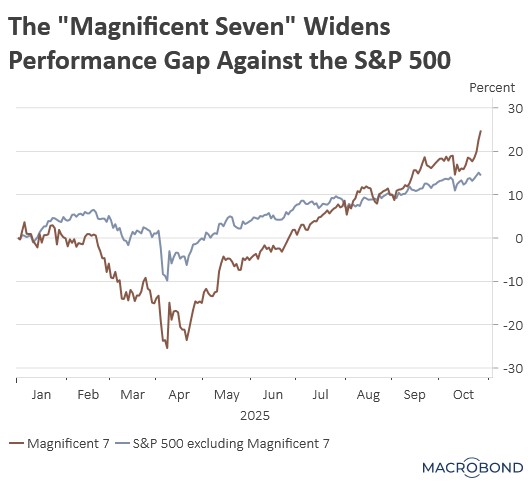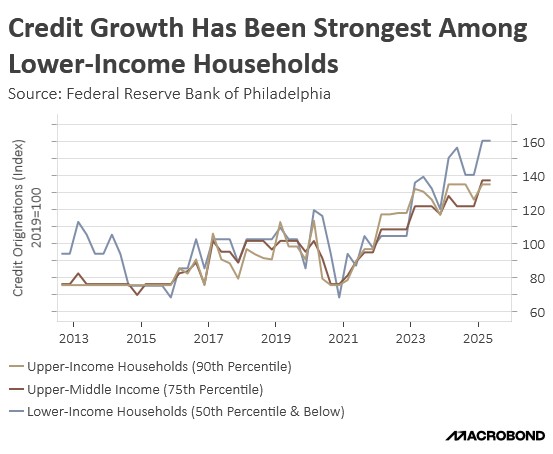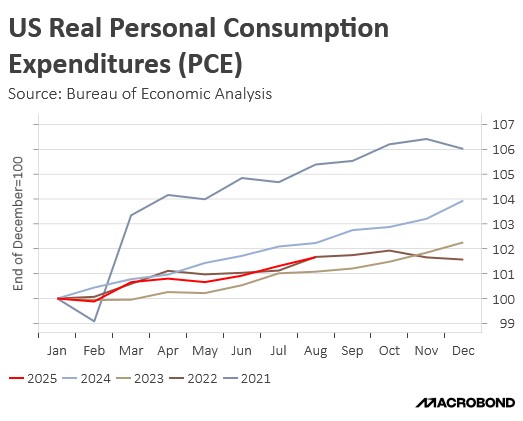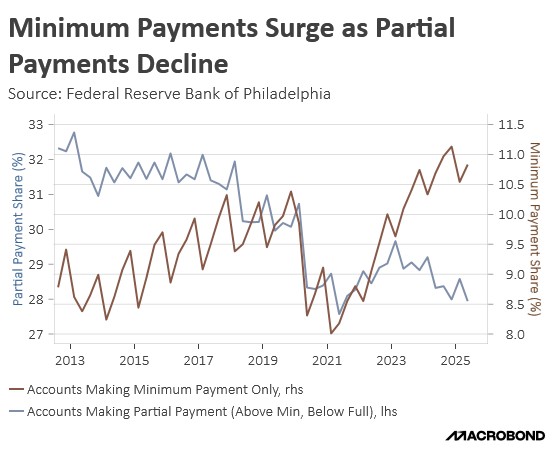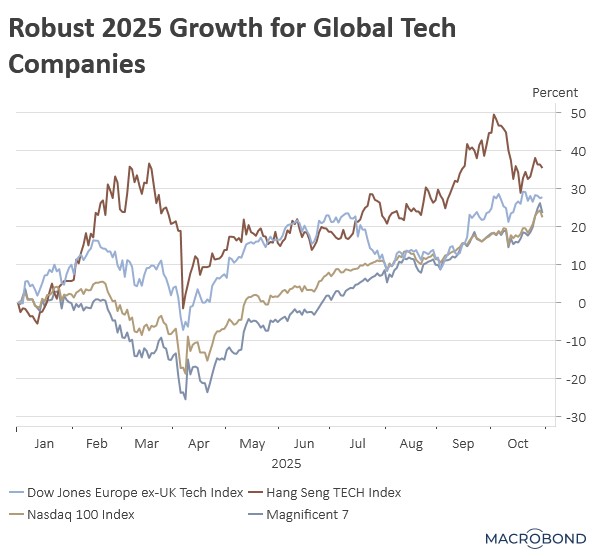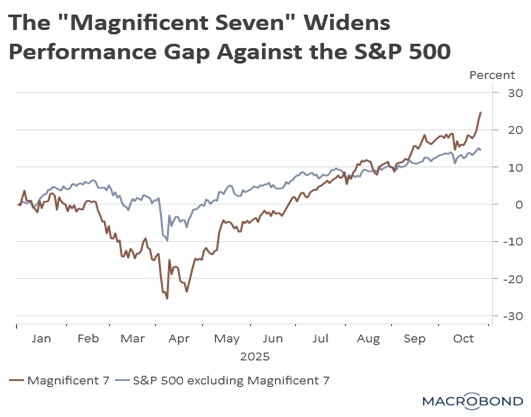Author: Amanda Ahne
Daily Comment (November 5, 2025)
by Patrick Fearon-Hernandez, CFA, and Thomas Wash
[Posted: 9:30 AM ET] | PDF
Our Comment begins with an analysis of Tuesday’s electoral contests. We then delve into the factors driving the recent cryptocurrency sell-off. Further coverage includes the continuing government shutdown, the EU’s relaxation of certain climate rules, and the escalation of US-Venezuela tensions. A summary of key domestic and international data releases is also included.
Democratic Sweep: In the first major electoral test of the cycle, strong Democratic turnout secured critical gubernatorial wins in Virginia and New Jersey. The party’s momentum extended down-ballot, with voters in New York electing Democratic Socialist Zohran Mamdani as the city’s next mayor and a key Pennsylvania Supreme Court race also falling in their favor. Overall, these outcomes suggest that voter dissatisfaction with the status quo is high — even with a relatively good economy — signaling a potentially contentious midterm election.
- The Democratic wins immediately intensify the national redistricting battle ahead of the 2026 midterms. Following partisan map-redrawing efforts in Republican-led states like Texas and Missouri, California responded by advancing Proposition 50. This ballot measure would allow the state to suspend its independent commission and implement new, legislatively drawn congressional maps to gain Democratic seats, effectively escalating a state-by-state partisan “arms race” for control of the US House.
- Given the White House’s “build fast and fix later” strategy, there is speculation that the administration could seek to inject additional stimulus into the economy. Such a move would likely be aimed at boosting economic sentiment to help the party in power retain control of both houses of Congress. This approach is consistent with current efforts to expand Medicare coverage for pharmaceuticals and pressure drug companies to lower prices, which are popular, consumer-focused policies.
- While the recent Democratic win might superficially suggest a shift in partisan allegiance, we propose a more fundamental driver: the global trend of electoral dealignment fueled by rising income inequality. Consequently, we anticipate that established political parties will be increasingly compelled to calibrate their platforms, adopting policies that appeal to lower-income households without alienating their wealthier base, a strategic maneuver essential for maintaining broad coalition support.
- That said, the broader political environment is poised to be favorable for equities leading up to the 2026 midterm elections. The administration is expected to utilize its policy levers for additional fiscal stimulus. Critically, the impact of the recent tax bill — likely generating larger tax refund checks for consumers and incentivizing greater capital investment — should provide a material boost, further fortifying an economy that has demonstrated consistent resilience.
Bitcoin Doubts: On Tuesday, bitcoin plunged below $100,000, a critical support level not seen since late June. This sustained decline is largely driven by long-term holders executing a risk-off strategy, having liquidated over $45 billion in holdings in the past month. The sell-off highlights a pivotal shift for the digital asset, which has recently gained popularity among retail investors while also attracting institutional flows due to recent regulatory changes.
- Although a single catalyst remains elusive, the recent downward pressure on crypto assets appears to stem from a confluence of three key factors: tech-sector deleveraging, a persistent liquidity crunch in the repo market, and growing interest in potential quantum-based alternatives to current blockchain protocols.
- Tech Narrative: Over the past few years, bitcoin has exhibited an increasingly strong correlation with technology equities. According to CME Group, bitcoin’s 60-day correlation with the Nasdaq 100 has risen from its near zero level prior to 2020 to as high as 60% over the past two years. This trend suggests that a portion of the skepticism surrounding crypto may reflect broader shifts in sentiment toward the technology sector as a whole.
- Repo Problem: Recently, there has been a rise in liquidity stress within the crucial repo market. This environment has forced various financial institutions to increasingly tap Federal Reserve facilities, such as the Standing Repo Facility and the Discount Window, to meet short-term funding needs. While there is no definitive link, the highly liquid nature of certain digital assets makes them prime targets for institutions needing to quickly raise clean capital
- Quantum Hype: Adding to long-term uncertainty is the emergence of “quantum money,” a theoretical alternative to code-based blockchain systems that would secure ledgers through the laws of physics rather than cryptography. Though still conceptual, recent breakthroughs in quantum technology — especially the release of specialized hardware like the Willow Chip — have fueled speculation about the eventual obsolescence of current cryptographic infrastructure.
- Of the three possibilities, the most concerning is that the crypto sell-off signals underlying liquidity strain. If confirmed, this could point to a broader systemic issue. While it is worrisome, the Federal Reserve does possess the necessary tools to manage such liquidity pressures. Therefore, we do not expect this specific issue to have significant long-term repercussions on the broader market.
Tech Skepticism: The tech sell-off persisted as mixed earnings reports dampened sentiment in the AI sector, keeping investors focused squarely on quarterly results. On Tuesday, chipmaker AMD beat expectations but offered weak guidance, and Super Micro Computer failed to excite investors with earnings that fell short of forecasts. The disappointing performance from these companies highlights the growing expectations for AI-related firms (particularly those outside of established tech giants) despite concerns over high valuations and weak underlying fundamentals.
Shutdown Tensions: The US government shutdown is now the longest on record, but a bipartisan compromise is finally emerging among centrist senators. The proposed deal involves immediately reopening the government with a short-term bill. In exchange, Republican leadership would commit to holding a dedicated vote on the expiring Affordable Care Act premium subsidies. This shift towards accepting a promise to vote, rather than a guaranteed extension, signals growing post-election momentum to resolve the standoff.
EU Soft Regulation: The European Union has agreed to scale back its ambitious 2040 climate targets following 18 hours of intense negotiations. The revised plan lowers the carbon emission reduction target to 90% and includes key concessions, such as delaying the expansion of its carbon pricing system and permitting member states to outsource a portion of their emission reductions to other countries. This policy shift is viewed favorably for European equities, as it reduces the near-term regulatory burden on domestic industries.
Venezuela Pressure: Venezuelan President Nicolás Maduro is escalating domestic repression in response to heightened US pressure over alleged drug trafficking. This American pressure, which has manifested as a ramped-up Caribbean military presence under the guise of anti-narcotics operations, is widely viewed as a modern echo of the Monroe Doctrine. This effort to reassert hemispheric dominance and deter states like Venezuela from partnering with China carries a real risk of escalation.
Daily Comment (November 4, 2025)
by Patrick Fearon-Hernandez, CFA, and Thomas Wash
[Posted: 9:30 AM ET] | PDF
Our Comment opens with an analysis of mounting concerns over a potential market pullback. We then examine how a wave of new AI partnerships continues to provide crucial market momentum. Our coverage further extends to government initiatives in the energy and commodities sector, conflicting signals from Fed officials on December rate cuts, and a notable shift in sentiment among UK youth regarding welfare benefits. We also include a summary of key international and domestic data releases.
Pullback Concerns: Wall Street leaders, such as David Solomon and Ted Pick, foresee a “healthy” market correction within the next 12-24 months, citing a dangerous divergence between valuation and fundamentals. While corporate earnings are robust, they are being vastly outpaced by exuberant price appreciation. This has created a clear schism where, on one side, there is analytical caution dictated by financial models, while on the other, there is a market psychology driven by unwavering faith in tech’s secular growth.
- Palantir appears to be driving today’s market narrative by serving as a prime example of the current tension in tech. Despite reporting robust earnings and providing strong forward guidance, its stock has declined. This counterintuitive sell-off highlights investor apprehension that a 175% year-to-date rally — and the resulting P/E ratio of 688.49 — has created a valuation that its underlying business performance cannot support, leading to renewed concerns of a sector-wide bubble.
- Historical precedent suggests this weakness is temporary. The Magnificent 7 have a track record of weathering periods of skepticism and early-year underperformance, consistently rallying to fuel broader market gains. In our view, the current negative sentiment mirrors these past episodes and is unlikely to derail the sector’s near-term trajectory.
- The case for sustained equity strength is compelling and rooted in a US economy that is demonstrating solid growth. Key data indicates twin engines of growth including unwavering household demand and a landmark acceleration in AI capital expenditure. Meanwhile, a labor market that is normalizing rather than weakening provides crucial stability. Given this combination of persistent demand and transformative investment, we anticipate further market appreciation, albeit at a potentially more selective and moderate pace.
AI Partnerships: The market is paying a lot of attention to the growing interconnectedness of tech companies. On Monday, Amazon Web Services (AWS) announced a multi-year, $38 billion agreement with OpenAI to provide it with massive cloud computing resources. The landmark deal is expected to significantly bolster confidence in AWS’s cloud computing infrastructure as it competes aggressively against rivals like Microsoft, Alphabet (Google), Oracle, and CoreWeave, all of whom are securing similar contracts to power the AI boom.
- Following the announcement, Amazon’s stock surged, a trend mirrored across the broader Magnificent 7 as investors continue to pour money into AI. The primary source of investor confidence is the robust and growing supply chains these firms are building, coupled with significant revenue diversification. This reassures the market that these companies have multiple avenues to justify their lofty valuations.
- Specifically, this move signifies that OpenAI is diversifying its cloud infrastructure beyond Microsoft, a strategic shift as it operates more like a for-profit company rather than a non-profit. Simultaneously, Amazon has solidified its status as a major AI player by securing OpenAI as a client, adding to AWS’s existing partnership with OpenAI’s rival, Anthropic.
- We anticipate a continued flow of strategic deals over the next few months as major tech companies aim to diversify both their revenue streams and supply chains. This proactive diversification is crucial for building resilient AI infrastructure and significantly reducing reliance on any single vendor. While we acknowledge that current tech valuations are elevated, we maintain that companies with strong balance sheets should see sustained momentum.
Government Investments: The White House has announced a series of new funding initiatives aimed at boosting US competitiveness in the commodities and energy sectors. On Monday, President Trump unveiled $100 million in funding for coal-related initiatives, although the specific source of the funds was not clarified. Additionally, the administration has committed $750 million to rare earth startups, a move that will involve the government taking equity stakes in the companies. These actions underscore the government’s growing role in the economy.
Rate Cut Doubt? Signals from Federal Reserve officials have cast doubt on the likelihood of a rate cut in December, revealing a split in their policy priorities. Chicago Fed President Austan Goolsbee emphasized that his dominant worry is persistent inflation, overshadowing labor market considerations. Meanwhile, Fed Governor Lisa Cook suggested her unease is more focused on the labor market’s health. This divergence creates a lack of clear guidance, which is expected to temper enthusiasm for risk assets as investors prefer the certainty of a dovish pivot.
US-China Trade Relations: In a sign of easing trade tensions, the US and China are moving toward normalizing relations. Chinese officials are expected to resume sales of rare earth metals to the US, while the White House has signaled a greater openness to allowing chip exports to China. These reciprocal gestures are likely to bolster confidence that the trade relationship will not be abruptly severed, even as the risk of future disputes remains. This should offer some support to the broader market.
EU Restraint: The European Union is considering measures to tighten its membership process, aiming to prevent the admission of what it might see as “Trojan horses.” The proposed plan would place new entrants on a probationary period before granting full membership, ensuring they do not backslide on democratic principles after joining. This measure is designed to prevent a repeat of situations like that of Hungary, which, after joining the bloc, subsequently cracked down on free speech.
UK Sentiment Shift: As the UK’s ruling Labour Party prepares to push through more tax hikes, polls show a growing number of young voters are expressing support for a crackdown on crime and benefits. This sentiment highlights the public’s growing dissatisfaction with the government as it struggles to manage the nation’s rising debt. The discontent appears to be fueling a rise in popularity for the Reform UK and Green parties, a sign that the traditional political duopoly is starting to lose favor.
Note: Due to the federal government shutdown, we were unable to update the Business Cycle Report this month. The report will return as soon as we are able to once again access government data.
Confluence of Ideas – #45 “Reviewing the Asset Allocation Rebalance: Q4 2025” (Posted 11/3/25)
Daily Comment (November 3, 2025)
by Patrick Fearon-Hernandez, CFA, and Thomas Wash
[Posted: 9:30 AM ET] | PDF
Our Comment today opens with news that key oil-producing countries have agreed to stop boosting output as the risk of a global glut becomes more evident. We next review several other international and US developments that could affect the financial markets today, including news that China will again allow the export of some Nexperia computer chips to avoid the risk of major disruptions to world auto production, while President Trump has said that China has promised not to attack Taiwan as long as he’s president.
Global Oil Market: The Organization of the Petroleum Exporting Countries and its Russia-led allies said they will hike oil production by another 137,000 barrels per day on December 1. However, they said they would then hold output steady to address the risk of an oil glut as global economic activity is set to slow in 2026. The announcement apparently aims mostly to keep oil prices from falling much further. However, we see no indication that the announcement will boost oil output and spur even greater OPEC+ output in the coming months.
China-Netherlands: The Chinese Ministry of Commerce on Saturday said it may exempt some Nexperia orders from an export ban that it imposed after the Netherlands seized control of the Chinese-owned Dutch chipmaker in October. In particular, global automakers were facing the prospect of having to shut down production due to a lack of Nexperia’s legacy semiconductors. China’s move to exempt at least some exports is evidently part of the framework of the US-China trade deal announced last week. News of the exemption should help buoy global stock prices today.
United States-China-Taiwan: In an interview over the weekend, President Trump said General Secretary Xi and other Chinese officials have assured members of the US administration that China will take no action to seize control of Taiwan as long as Trump is president, ostensibly “because they know the consequences.” It’s not clear if the Chinese have offered a formal commitment regarding Taiwan, but to the extent that they have, it would likely reduce the risk of a disruptive US-China military clash and be supportive of both countries’ stock markets.
China: New data shows the third-quarter earnings of China’s mainland-listed companies were up 11.6% from the same period one year earlier, accelerating from annual gains of just 1.2% in the second quarter and 3.2% in the first quarter. The figures suggest the government is having some success with its policies to rein in excess capacity and fierce price competition while also pumping up corporate and consumer stimulus. The recovery in profit growth is probably a key reason why Chinese stocks continue to appreciate strongly.
Japan-South Korea: Underscoring the positive comments from Japan’s newly installed Prime Minister Sanae Takaichi after meeting South Korea’s leader last week, South Korean President Lee Jae Myung on Saturday said he also “had a very good feeling [about Takaichi]. All my worries vanished.” The mutually laudatory remarks from Takaichi and Lee suggest that Japanese-Korean relations remain on track and are unlikely to be disrupted in a way that would weigh on either country’s economy or stock market.
United States-Nigeria: President Trump on Saturday said he has ordered the Pentagon to prepare for a possible US military intervention in Nigeria to protect its Christians from ongoing attacks by the country’s Islamist militants.
- US attacks on the militants don’t appear to be imminent, but the rhetoric may unsettle many isolationists in the president’s political coalition because it would likely remind them of the US’s long wars in Iraq and Afghanistan.
- The statement might be especially unsettling after the US’s recent participation in Israel’s attack on Iranian nuclear sites.
US Dollar: According to the Financial Times, officials at the White House, the Treasury Department, and other federal agencies are looking for ways to encourage more foreign countries to use the dollar as their main currency. The effort reportedly aims to push back against China’s effort to undermine the dollar and boost usage of the renminbi.
- Nevertheless, we see no evidence that any major economy is considering a shift to using the dollar, so the effort seems unlikely to change the greenback’s developing bear market.
- Since foreign stocks typically outperform US stocks when the dollar is weak or depreciating; any continued trend in that direction is likely to be positive for foreign stock returns versus US stock returns.
Czech Republic: After winning the most votes in last month’s elections, but not a majority, the ANO party of Eurosceptic billionaire Andrej Babiš today will sign a coalition deal with two far-right parties, allowing Babiš to become prime minister. The inclusion of the far-right parties will likely make the Czech Republic another source of irritation and policy resistance for European Union leaders in Brussels. For example, the country will now be more likely to resist aid to Ukraine, greater EU integration, and rule-of-law mandates from Brussels.
Note: Due to the federal government shutdown, we were unable to update the Business Cycle Report this month. The report will return as soon as we are able to once again access government data.
Asset Allocation Bi-Weekly – #151 “When the Financial System Finds a Cockroach” (Posted 11/3/25)
Asset Allocation Bi-Weekly – When the Financial System Finds a Cockroach (November 3, 2025)
by Thomas Wash | PDF
No one likes finding a cockroach, especially in a place that should be clean, like the financial system. Last month, JPMorgan CEO Jamie Dimon issued a warning, suggesting that isolated loan failures — the “cockroaches” — are pointing to a much broader credit risk problem. He specifically flagged risky loan assets held by specialized lenders such as TriColor, stating that their poor performance is likely evidence of a generalized decay in loan quality across the consumer sector.
The deterioration in loan quality appears to reflect a mounting consumer debt burden that is now leading to significant household financial strain. Credit card delinquencies have surged to their highest level since the 2008 financial crisis, underscoring this pressure. In response, lenders are tightening underwriting standards and curbing new card issuance, particularly to subprime borrowers. This defensive shift indicates that the rise in defaults is largely concentrated among existing borrowers rather than driven by a fresh wave of risky lending. Yet, there is more to the story.
The recent rise in delinquencies can be partially traced to the massive expansion of consumer credit since 2019, especially among lower-income households. Credit availability for the bottom half of cardholders has surged nearly 60%, allowing many to maintain consumption amid persistent inflation. While this expansion has inevitably increased overall debt burdens, it has also enabled households to preserve spending power by spreading purchases into smaller, more manageable payments rather than paying the full cost upfront, even as real incomes have struggled to keep pace.
This surge in consumer credit has been a key mechanism sustaining consumption during recent periods of economic uncertainty. Despite repeated recession warnings over the last three years (citing the 2022 market contraction, 2023 failure of Silicon Valley Bank, and fleeting 2024 Sahm Rule alarm), aggregate consumption has remained remarkably resilient. While recent tariffs have slowed consumption compared to the previous year, the overall pace remains consistent with the strong trend that was set over the last four years.
While pockets of consumer weakness are evident, the broader systemic risk still appears to be limited. Subprime borrowers, despite the expansion of credit, hold a relatively small share of total household debt. According to Moody’s Analytics, subprime loans stood at $2.63 trillion in September, or about 15.3% of household debt. That’s a far cry from 2007 when subprime exposure reached $3.38 trillion and accounted for 28.2% of the total. The current, much smaller concentration suggests that today’s risks are more contained.
Furthermore, the immediate impact of weakness in the consumer credit market on the broader economy is likely to be muted. This continued stability in the economy is rooted in the labor market, where unemployment remains relatively low. Firms have largely retained staff, even while curtailing new hiring. The persistence of high employment means households should still be able to meet the minimum payments on credit cards and other consumer loans, suggesting their financial perseverance may last longer than many observers anticipate.
In addition, the overall US economy and total consumption expenditures are currently disproportionately dependent on high-income households. For example, the top 20% of earners account for approximately 40-50% of all consumer spending (depending on the specific measure and source). This significant concentration means that while low-income households may be forced to reduce spending due to financial strain, the overall momentum of the economy can be sustained by the resilience of the wealthiest earners.
As noted by JPMorgan, the appearance of “cockroaches” in consumer credit confirms a structural weakness. However, we conclude that this distress is a medium-term challenge, not a short-term systemic threat. This assessment is rooted in three factors: the resilience of the high-income consumer, the contained nature of subprime debt, and the strength of the jobs market. We therefore remain confident in projecting continued economic momentum and even an acceleration in economic growth next year, which should directly support strong corporate earnings and sustained broad-based support for equity markets.
Don’t miss our accompanying podcasts, available on our website and most podcast platforms: Apple | Spotify
Daily Comment (October 31, 2025)
by Patrick Fearon-Hernandez, CFA, and Thomas Wash
[Posted: 9:30 AM ET] | PDF
Our Comment begins with an examination of the US push for a digital free-trade economy. We then assess the ongoing government shutdown and its implications. Further coverage includes the Senate’s movement on tariff-repeal bills, the role of corporate earnings in bolstering tech sector sentiment, and the EU’s development of a new trade strategy to counter China. We also include our regular summary of critical international and domestic data releases.
US Digital Service Economy: The White House is aiming to preserve the US global trade surplus in services by championing tariff-free digital commerce. This move signifies a broader strategic shift as the US redefines its economic dominance by emphasizing global technology access over traditional consumer market access. Such tailored policy making demonstrates a clear alignment with the interests of Silicon Valley, granting those companies a significant political and economic advantage on the world stage.
- To implement this strategy, the administration has leveraged tariffs on goods to dissuade foreign governments from imposing barriers on US tech companies. The plan has already seen some success. The White House has secured commitments from nations like Malaysia, Cambodia, and Thailand that they will not impose restrictions, while also convincing major partners, including the EU, Britain, and Canada, to openly discuss loosening their digital services regulations.
- While tariff-free digital services encompass a wide range of commerce — including social media, streaming, and cloud platforms — this policy is also critical to the US ambition for global dominance in AI. As detailed in our Bi-Weekly Geopolitical Report, “The Great AI Race,” the United States is actively trying to construct a technological ecosystem where it sits at the center of the AI supply chain, ensuring that both the core technology and supporting equipment are manufactured domestically.
- The growing partnership between the White House and Silicon Valley marks a significant strategic shift in US economic policy. By leveraging tariffs on goods to push for deregulation in foreign markets, this alliance aims to secure crucial market access and vital resources for American tech giants. However, this support comes at a clear cost: companies must align their business plans with Washington’s policy initiatives.
- In the near term, this alignment should accelerate the expansion of US tech firms and boost returns. However, we project that long-term profitability may be hampered by the political friction this partnership generates. Furthermore, we anticipate other nations will resist this trend to protect and bolster their own domestic industries, reducing their reliance on the US. This resistance could, in turn, spur increased investment into their own local tech champions.
Government Shutdown: Friction is escalating within both political parties as the government shutdown extends into its fifth week, with neither side showing an immediate willingness to concede on key demands. November is shaping up as a critical inflection point as millions of vulnerable households reliant on SNAP (food stamp) benefits may begin to see those funds dry up. Furthermore, the expiration of federal funding risks a significant spike in Affordable Care Act health insurance premiums if existing COVID-era subsidies are not renewed before the deadline.
- The Democratic caucus is under increasing strain to approve a clean government funding bill proposed by Republicans. This mounting pressure is driven by key labor leaders, particularly those representing airline industry workers and government workers, whose constituents are missing paychecks. The situation is further complicated by Senators such as Jon Ossoff (D-GA) and John Fetterman (D-PA), who face competitive re-election battles and are viewed as possible defectors seeking a quick end to the political standoff.
- Simultaneously, Republicans are beginning to question their party’s strategy for resolving the impasse. They are now debating whether to allow SNAP benefits to lapse — a move that would sever a key source of funding for vulnerable households. Furthermore, there is growing concern that the prolonged shutdown will complicate efforts to pass other critical legislation.
- The White House has so far adopted a nuanced strategy during the shutdown. While the president has expressed a willingness to work with Democrats on modifying the Affordable Care Act to better serve working families, he has simultaneously urged Republicans to pursue the “nuclear option” of eliminating the legislative filibuster, which requires 60 votes for most bills to pass.
- The shutdown is not expected to severely impact near-term economic activity, but the financial toll increases daily. Our main concern is the effect on consumer sentiment, which is already low. Consequently, a prolonged shutdown could quickly reduce household spending, especially among low-income earners sensitive to financial uncertainty and payment delays.
Senate Tariff Challenges: The Senate passed bipartisan legislation to repeal the president’s use of sweeping global tariffs imposed on US allies. Although the bill is unlikely to be taken up in the House or survive a presidential veto, it represents a growing, cross-party resistance to the executive’s trade restrictions. This political maneuver is unfolding as the White House anticipates a Supreme Court hearing that will rule on the constitutional limits of the president’s authority to unilaterally impose tariffs without congressional approval.
Tech Sentiment Strong: Tech sector sentiment received a necessary boost following strong outlooks from Amazon and Apple. Amazon Web Services (AWS) beat cloud revenue estimates, while Apple, despite a current revenue dip due to soft China sales, announced expectations for its best-ever December quarter revenue. Given the ongoing market headwinds and policy uncertainty, we maintain our view that corporate earnings remain the single most critical factor for judging the sustainability of the current market rally.
EU Trade Strategy: To address Chinese import dumping, the European Union is devising a novel toolkit that moves beyond traditional tariffs. Key proposals include “in-kind” tariffs that require Chinese exporters to directly supply the EU’s strategic reserves of critical raw materials or mirroring China’s own tactics by restricting exports of key goods. This delicate balancing act highlights the EU’s primary objective to reform China’s unfair trade practices without jeopardizing the very mineral resources essential to its own green and digital transitions.
More Oil: Exxon and Chevron surpassed market earnings expectations as new oilfield acquisitions boosted their crude output. This production increase comes amid signs of a supply glut, driven by the OPEC+ alliance flooding the market to retain market share. The situation suggests that oil prices may face downward pressure as major players compete for dominance in an increasingly competitive global market.
Note: Due to the federal government shutdown, we were unable to update the Business Cycle Report this month. The report will return as soon as we are able to once again access government data.
Daily Comment (October 30, 2025)
by Patrick Fearon-Hernandez, CFA, and Thomas Wash
[Posted: 9:30 AM ET] | PDF
Our Comment begins with our key takeaways from the October 28-29 FOMC meeting. We then assess concerns over elevated tech spending and explain why it is unlikely to derail near-term sector momentum. Additional analysis covers the newly agreed US-China trade truce and the implications of stronger-than-expected economic growth in Europe. We conclude with our regular summary of critical international and domestic data releases.
Fed Division: The FOMC’s widely anticipated 25 basis point rate cut at its October meeting laid bare a deepening rift on the committee. The vote revealed a sharp division, with dissents coming from both sides of the debate. Kansas City Fed President Jeff Schmid argued for no cut at all, while Governor Stephen Miran championed a deeper 50-point reduction. This rare public split underscores the central bank’s fundamental challenge of navigating the conflicting demands of its dual mandate to foster both maximum employment and price stability.
- The division was further reinforced at the press conference when Fed Chair Jerome Powell bluntly stated that a December rate cut was not a “foregone conclusion.” This clear, direct remark — a contrast to his usual guardedness and hedged approach regarding policy — suggested he intended to aggressively rein in market expectations as Fed officials themselves still grapple with the proper direction for monetary policy.
- Investor sentiment shifted decisively following the Fed’s announcement as the S&P 500 relinquished its advances and the dollar strengthened. This market move was a direct response to the hawkish undertones of the rate cut, underscored by internal dissent and Chair Powell’s uncharacteristically blunt communication, which together signaled a potential extended pause in the easing cycle.
- Adding significant risk to the policy outlook, the government shutdown is effectively blinding the Federal Reserve, undermining its commitment to being data dependent. The halt to official statistical releases means the central bank must now operate without its most reliable economic indicators. Though Fed officials are referencing private and survey data, these sources are demonstrably less robust and statistically noisier than timely government reports.
- That said, Wednesday’s market decline likely reflects growing conviction that the Fed will not cut rates in December. This shift is clear in the CME FedWatch Tool, which now shows a 70% probability of rates holding steady through year-end, up sharply from 30% just a week ago. Should these rate expectations reverse, it would likely boost equity prices broadly, with particularly significant gains for interest-rate-sensitive sectors.
Big Tech Tests Investors: While this year has seen a surge in AI-related capital expenditures, firms expect this high level of spending to continue into next year. The trend is driven by continued heavy investment in data centers and infrastructure from tech giants like Meta, Microsoft, and Alphabet. Although these companies maintain that the spending is necessary to meet rising demand, there are growing concerns that it could be fueling a market bubble.
- Investor anxiety over soaring capital outlays sparked an immediate pre-market retreat in tech stocks. The trigger seemed to be the staggering scale of AI-related investment: Alphabet, Meta, and Microsoft collectively poured $78 billion into capital expenditures last quarter, an 89% jump from a year earlier. Meta’s guidance for “notably higher” spending further fueled bubble concerns, especially since it is not a major cloud provider serving external clients, making its investments appear riskier.
- That said, drawing a comparison to the tech bubble of the1990s may be premature, given fundamental differences in corporate health. Crucially, the major companies driving the current AI boom — unlike their dot-com predecessors — possess verifiable profits, diversified revenue streams, and massive cash reserves. This robust financial foundation provides a strong buffer against any sharp market downturn, lending momentum and stability to these stocks, at least over the immediate horizon.
US-China Trade Deal: The US and China have agreed to a one-year trade truce, though it falls short of the comprehensive deal many anticipated. The agreement includes a suspension of new trade and investment restrictions. Key concessions included the US agreeing to reduce fentanyl tariffs to 10% and lift certain corporate restrictions, while China committed to resuming soybean purchases and rare earths exports. While this alleviates immediate pressure, it sets the stage for potential renewed tensions next year.
- Although this falls short of the comprehensive deal that markets were anticipating, it serves as a strategic pause. This interim period will likely be used by the US to accelerate the diversification of its critical mineral supply chains away from China, and by Beijing to advance its campaign for technological self-reliance, particularly in chips.
- The truce is likely to sustain equity market support, as it alleviates supply chain strains and safeguards the resilient earnings trajectory seen in recent quarters. However, the underlying uncertainty in US-China trade relations is expected to re-emerge as a major investor concern in 2026.
Eurozone Resiliency: Third-quarter GDP for the eurozone came in stronger than forecast, growing by 0.2% against a 0.1% consensus. The outperformance was largely due to a surprisingly strong 0.5% expansion in France — its fastest pace since 2023 — which more than offset a stagnation in Germany. France’s resilience amid political uncertainty is likely to bolster investor confidence, supporting the view that the region’s strong equity performance can continue.
Centrist Win in Netherlands: The centrist-liberal D66 party is projected to win the most seats in the Netherlands, narrowly defeating the far-right Freedom Party. This outcome represents a rare setback for right-wing populists in Europe, a movement that has largely gained popularity in recent years. While some speculate this result could inspire similar shifts across Europe, we believe the Dutch vote reflects a deeper trend of rising income inequality eroding loyalty to any specific parties, creating a more volatile political landscape.
Nuclear Testing: The White House has announced plans to resume nuclear weapons testing, a move aimed at modernizing US defenses and countering advancements by strategic competitors China and Russia. This decision follows the recent authorization for South Korea to build nuclear submarines and reflects a broader pivot in the administration’s foreign policy. Despite a stated agenda of conflict resolution, President Trump is simultaneously adopting a more hawkish stance to address rising global tensions.



